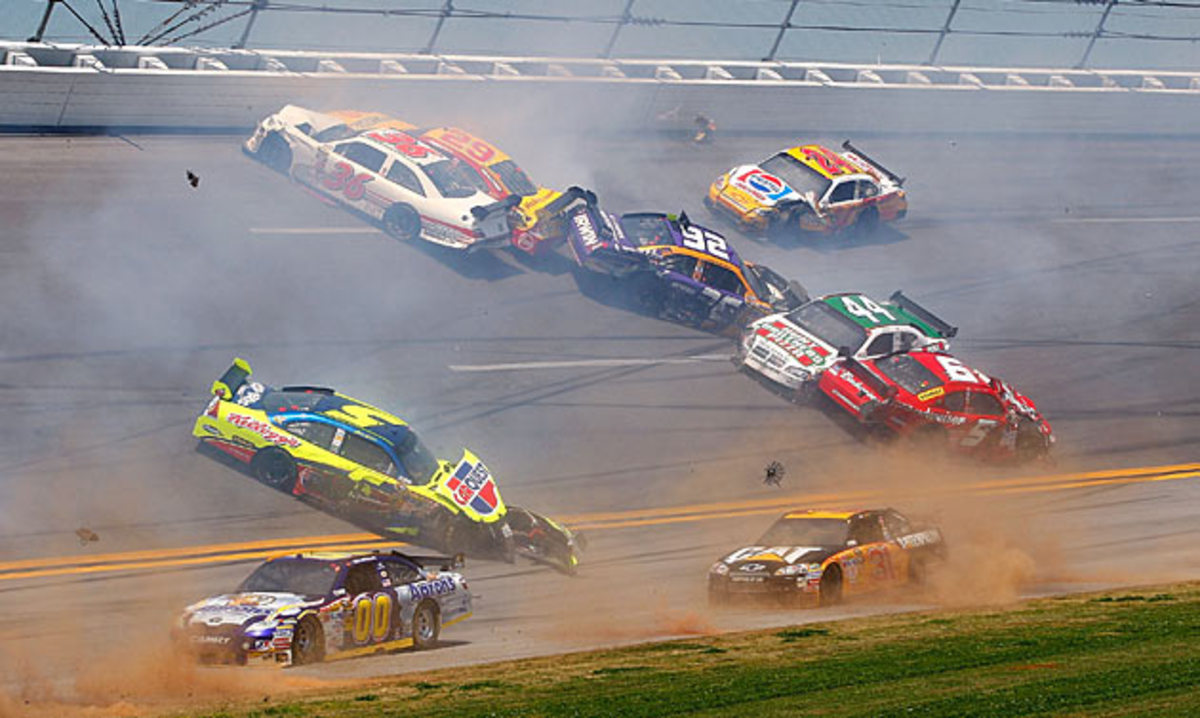Talladega's Big Ones crash lore looms over new Chase race

A severe storm warning will be in effect for NASCAR Nation on Sunday. Fans are advised to make sure they have enough supplies to survive a few hours without leaving their seats, be they at home or in the stands at Talladega Superspeedway. There the storm should make landfall sometime after 2 p.m. ET (ESPN), when the green flag is expected to drop on the Geico 500.
Watch: Talladega Superspeedway's Big One wrecks through the years
plates brought the speeds down (albeit still close to 200 mph), but they also made the cars less responsive to throttling—which makes it all but impossible for drivers to get away from one another.
So they race in giant packs, three and sometimes four abreast, no car more than three feet away than the next. All it takes is a slight lapse in concentration, or a funky wind gust, or a piece of flotsam landing in the pack’s path for lightning to strike and send a giant chunk of traffic gathering in a Day-Glo cloud of hot twisted metal. They call it the Big One, and at best it might take out five cars; at worst it might take out 20. Either way, fans will be thrilled.
Racers, though, have extra reason to fear the Big One. Unlike in previous autumns, when Talladega was a Chase wildcard—but one in a playoff series that picked a winner based on cumulative performance over 10 races—this year ’Dega looms as essentially a sudden-death wildcard: In the revised playoff system, now, the Chase for the Cup picks its winner based on round-by-round performance. This Sunday, the field’s 12 best drivers over the past five weeks will be winnowed to eight.
Joey Logano and Kevin Harvick can drive without worry thanks to their victories at, respectively, Kansas and Charlotte in the last two weeks. But equally big names such as 2012 Cup champion Brad Keselowski (currently 10th in the standings), one-time 2014 season frontrunner Dale Earnhardt Jr. (11th) and six-time series titlist Jimmie Johnson (12th) will need a win to make the cut. The fact that all three have triumphed at Talladega more than once—five times in Junior’s case—is no reason to get cocky. “Stats, says Denny Hamlin, a ’Dega victor just five months ago, “don’t matter there.”
Still, history does. With the forecast calling for a white-knuckle ride the likes of which has never been seen, we have impaneled a few track regulars to share their experiences racing NASCAR’s most mercurial circuit.
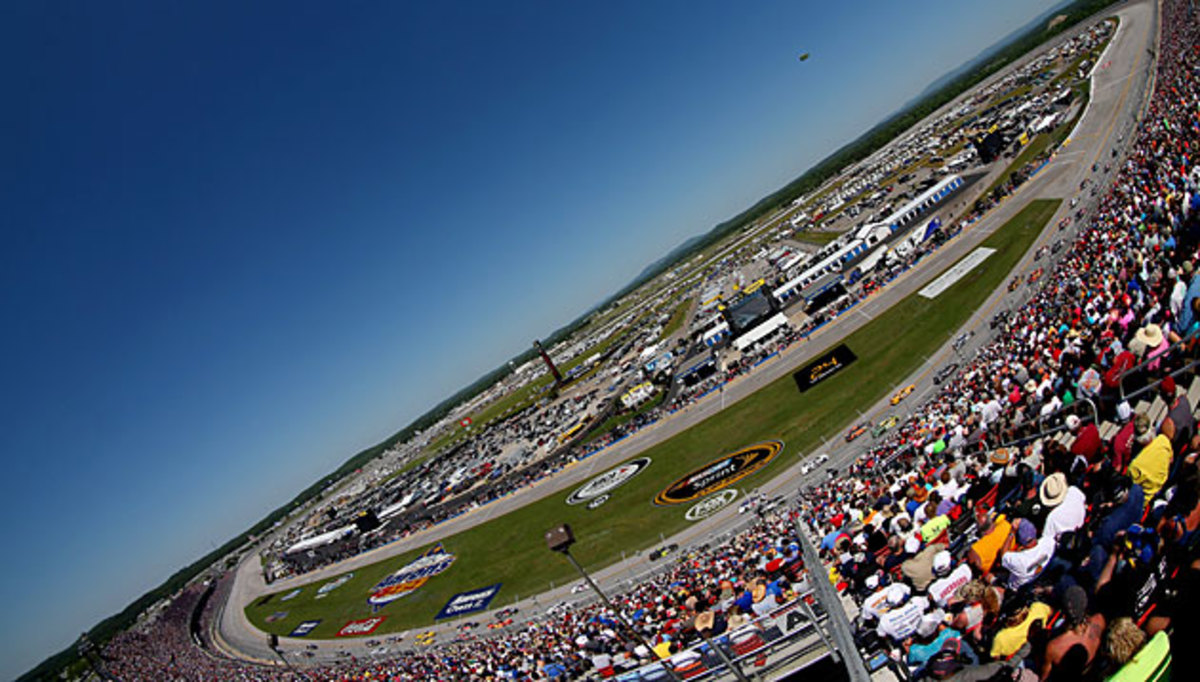
Richard Petty, two-time Dega winner, inaugural NASCAR Hall of Famer: “Well, [the track] was built an old Indian burial ground and the locals say that it’s cursed. [laughs] Go check that out. “
Grant Lynch, track manager: “Jim Hunter started all that. He was [NASCAR founder] Bill France’s right-hand guy for many years. And in the old, old days he was the PR director here. He was trying to come up with some way to build the mystique of Talladega. So he put together [laughs] kind of a little public relations deal of talking about how Talladega was built on an old Indian burial ground. You hadn't heard this? You heard the Bobby Isaac story, right?”
Ninety laps into a race in 1973, Isaac stopped driving and parked his car. By way of explanation, he would say that he was guided by voices that only he could hear.
Grant Lynch, track manager: “Jim was just building on that. In this day and age, obviously, you wouldn't talk about being built on an Indiana burial ground. And even if you were, you just wouldn't talk about it because of the sacred nature of that.”
Bill Moss, track engineer: “Let me just tell you this: everybody forgets that there was a United States Army Air Force airfield there before we ever showed up. It wasn't a heavy duty airport, more for small twin engine planes.”
Mike Helton, NASCAR president, former track manager: “If you look at an aerial shot, you can literally see the old concrete runways outside the track disappear underneath the racetrack and then come out in the infield.”
In 1959, 12 years after founding NASCAR, France completed construction on Daytona International Speedway. At 2.5 miles, it was a big track, equal in size to the storied Brickyard in Indianapolis. But the land on which the track was built left France little room for growth. The experience not only steeled his determination to build a larger track, but also one on a much more sizable plot than the one in Florida. An Alabama county agent got wind of France’s plans and encouraged him to take a look at the base and its surrounding land.
Russell Branham, Talladega director of public relations: “Hal Marchman, a pastor who is no longer with us, said France called him one day and said, ‘Let’s fly to Talladega and take a look at some property.’ Marchman said as they flew above the property, France kept talking about a 2.66-mile superspeedway. Marchman said all he saw was dirt, old runways and cotton fields.”
As Moss remembers it, France paid $9 million for some 3,000 acres with financial backing from Union Oil. The fact that there was an air base in the middle of the place where he planned on building the track didn’t affect his vision.
Moss: "[France] wanted the fastest track in the world, and we built what he asked for.”
Helton: “[France] wanted to build another facility similar to Daytona—but actually he wanted to build it such that you could set Daytona down inside of it. Daytona's 2.5 miles and Talladega is 2.66 miles. It's just a tick bigger. Our series is made up of a lot of unique facilities. But Talladega is Talladega. It's got the reputation of being fast and furious.”
Bill Elliott, two-time ’Dega winner, 2015 NASCAR Hall of Fame Class: “Well, Talladega was probably a love-hate relationship. You can be in the front, you can be in the back, you can be wherever. It just doesn't matter. You can wreck anywhere.”
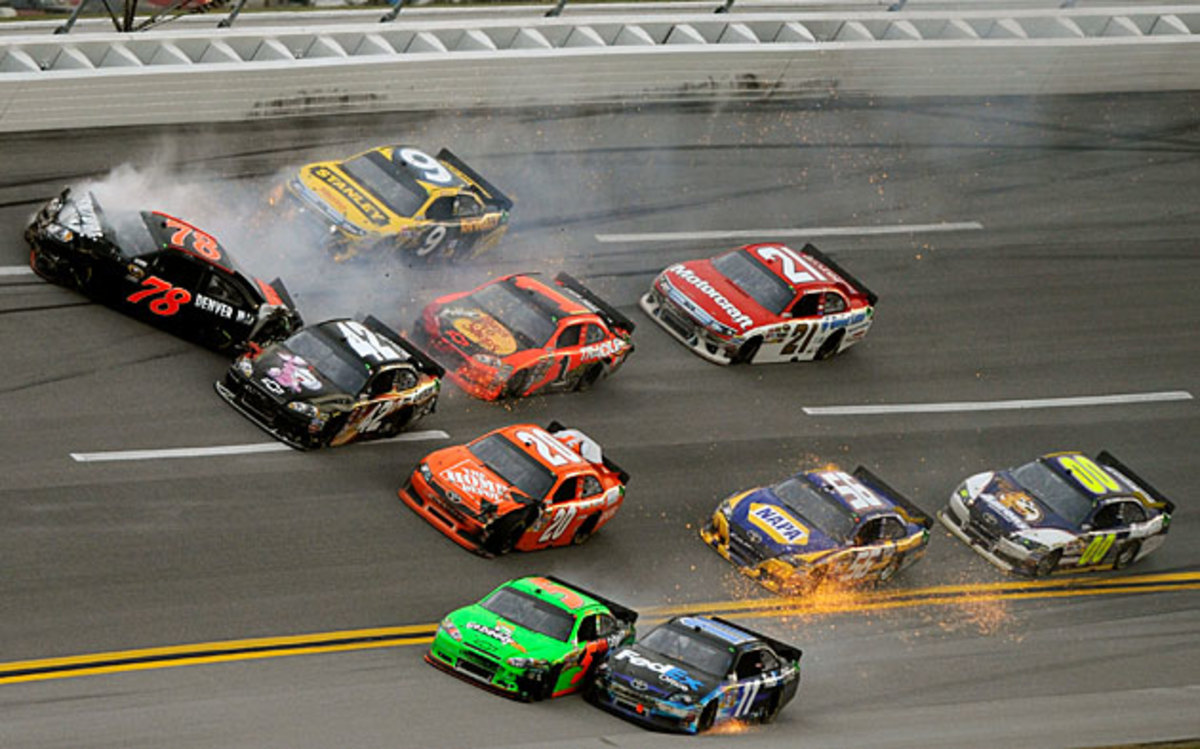
Petty: “Some of the drivers are really good on short tracks. Some of ’em are good on road courses. Some of them are good on mile-and-half tracks. But running there, it doesn't make any difference how good you are. It's just a mixed bag. You just have to hang on and hope it's your day. I told them boys a lot of times, just bring me back four wheels and a steering wheel, and I know we've finished pretty good.”
Elliott: “Well, you've gotta understand in my generation when I came through there if you were in the big one, the odds of you surviving it was less than the guy today because of all the safety measures. I've seen a lot of people killed at that place over the years, not necessarily in Cup, but in some of the other series.”
Jim Gairo, ESPN NASCAR producer: “The most important thing is you don't rush to replay [a Big One]. You want to make sure that everybody's okay. Once you kinda identify those are involved, the window nets are down, everybody's okay. All right, now let's go to the replay. You start off high. But by the time you get to those on-board cameras, that's where your respect level for those drivers increases so much. You see them going at these speeds, you see cars flying left and right. And I'm a huge sports fan. People call me a stick-and-ball producer more than racing, but as a visual nothing compares to the on-board cameras in a big wreck because you're seeing absolute carnage. It's absolutely amazing that these cars are going that fast and you see them make decisions on how to get through and you see a car going upside down on top of you. It's stunning.”
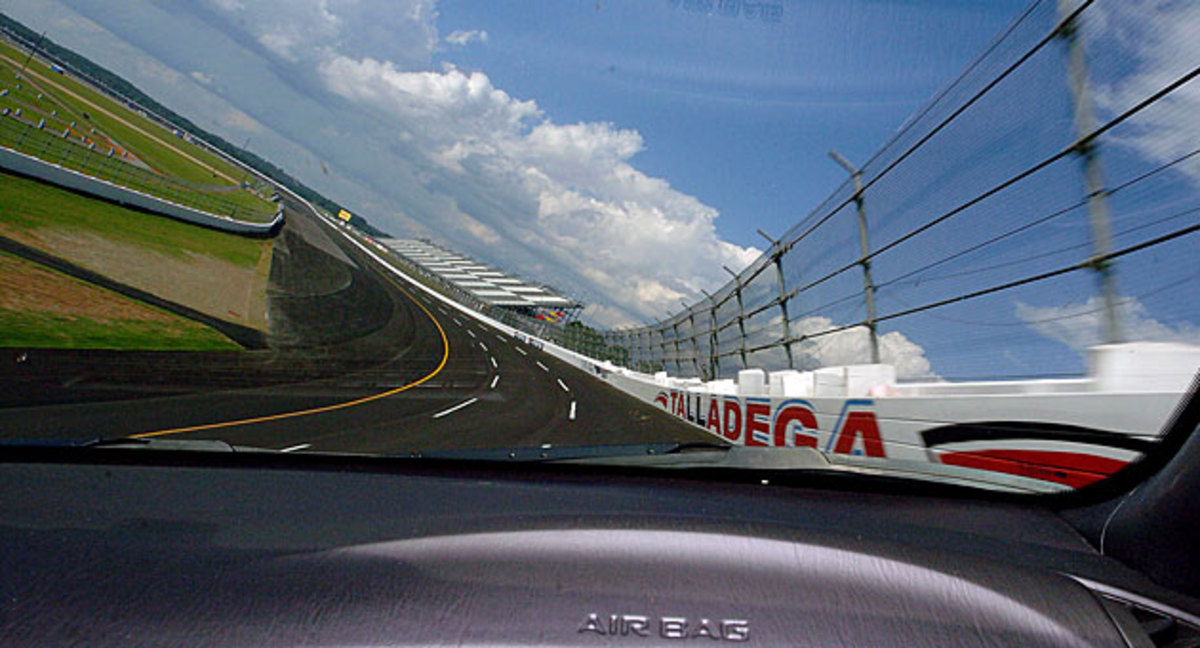
Elliott: “I'd say as far as accidents, I hit the wall at the start-finish line there in ’98? I got together with Ward Burton turning head-on into the wall. That was probably one of the worst wrecks that I've done. I was sliding on my side on fire with Dale Earnhardt's car literally—I was like this, and he was sandwiched on top of me [folds his hands]. He was flying down the frontstretch. It was big.”
Helton: “I remember somewhere in that [pre-restrictor plate] era the entire field at Talladega qualified at over 200 mph. That was big deal. Bill Elliott I think sat on the pole. But the entire field behind him down to the 43 spot was over 200 mph. We've done so much work on trying to get a car to try and stay on the ground. But the uniqueness of Daytona and Talladega is that without the plates they would probably be running 220 or 224. Just because it's so big. Even the turns are high banked and they're wide and the cars can do more in those environment. It comes with a balance. We haven't figured out a way to replace the restrictor plates, so they've been there since '87 or '88.
Petty: “When they did slow it down with the restrictor plates, it made all that [crashes] worse. Because instead of 10 cars, there's 20 cars. Or instead of 20 cars there's 40 cars. So that just compounds the problem. If you have cars running 220 mph and then you have cars running 190, you wouldn't have that much to deal with. But the deal is when they get to running, they get in the draft and they get sucked up in there. It's crowded. [laughs] It gets too crowded. Everybody's wanting the same spot.”
Elliott: “When the race starts, the guys'll give you three feet. They really are cautious. You get halfway, and it's down to two feet. You get to two-third of the race, and it's down to an inch or two. You get to the last third and it's wham-bam. And you expect that. It's just part of what it is.”
Gairo: “What's interesting is you would think it would be tougher to broadcast there [because it’s so big], but it almost becomes easier because its pack racing and all the cars are up front. They're two-wide, three-wide, four-wide. So it's not like you have to hold and look at the battle for fifth. Well, the battle for the lead all the way to the battle for 25th is one big pack. It's like when you do a football game sometimes you're at Camera 1, the wide shot of the play. We try to stay as wide as possible while intercutting our onboard cameras, our robotic cameras, our wall cameras. Some of the best visuals in NASCAR are at Daytona and Talladega where you've got a wide camera of the backstretch and you're three wide for 10 rows. As a producer you're holding your breath, like holy crap, on any lap the Big One could happen.”
Brad Keselowski, two-time ’Dega winner, 2012 Sprint Cup champion: “At Talladega, you're more than trusting your fellow competitors. It's like the difference between having a friend and living in the same house with that friend.”
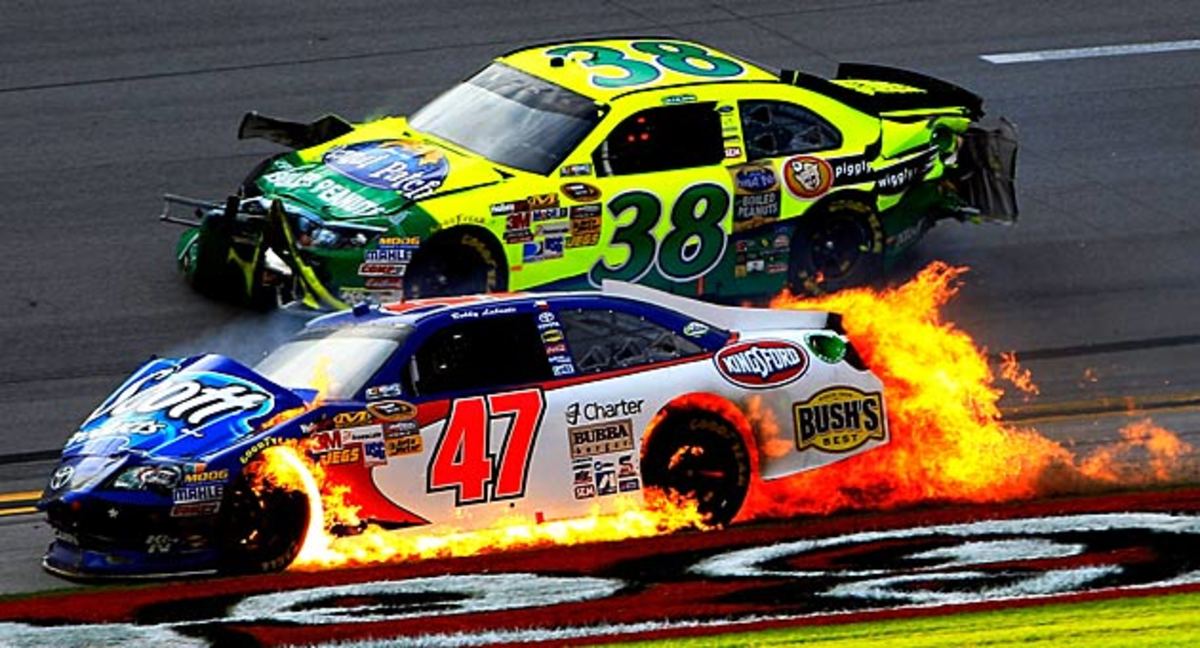
Luke Lambert, crew chief for 15-year veteran driver Ryan Newman: “The adjustments that we make are not as important necessarily as they would be at a mile-and-half or any of our handling or downforce tracks because the car's not at the limit handling for a lot of the lap. The handling conditions are based on the air around the car way more than the actual way the car is set up through the track itself. One thing that I think is really the biggest challenge when you're calling a race at a superspeedway is the green flag pit cycle. They'll be like a two- or three-lap window right there where everybody'll pit. Well, it's key that you come down with the cars, preferably good cars, as long as you guys don't jumble each other up on pit road. And then you have smooth efficient pit stop where you all come back out together and reascend the draft like immediately. You can actually hurt yourself there by getting yourself on an island and potentially lose the draft if something bad were to happen to you.”
Kurt Busch, 2004 Sprint Cup champion: The restrictor plate is what is called the great equalizer. It makes it to where you can have the least amount of experience and still run up front. I'm a perfect example. My first time to Talladega, I finished third. I mean I'm a flat-out rookie. I have no idea what I'm doing; I finish third. Trevor Bain won the Daytona 500 a couple years ago. He has zero experience. And he was able to win the race.”
Lynch: “So many people, the only race they've won—and there's a bunch of ’em—they've won Talladega and they've never won again. There's probably seven or eight out there that it's the only race they've ever won.”
Busch: That's what the restrictor plate does. It just makes everybody equal, it bunches everybody together and the Big One happens when somebody has a lapse in their judgment. And it could happen even with a mechanical failure. Somebody could drop a cylinder running up front, and then the whole accordion comes in and [explosion noise] everybody wrecks. There's so many factors that lead into the Big One.”
Joey Logano, seven-year Sprint Cup veteran: “I'm gonna be 100% honest with you: I don't like it there at all. Because I feel there are way too many other people out there that can determine your future. Because what someone else does is gonna alter what my day is gonna be. One move that changes the lane, and then all of a sudden it [the race] changes.”
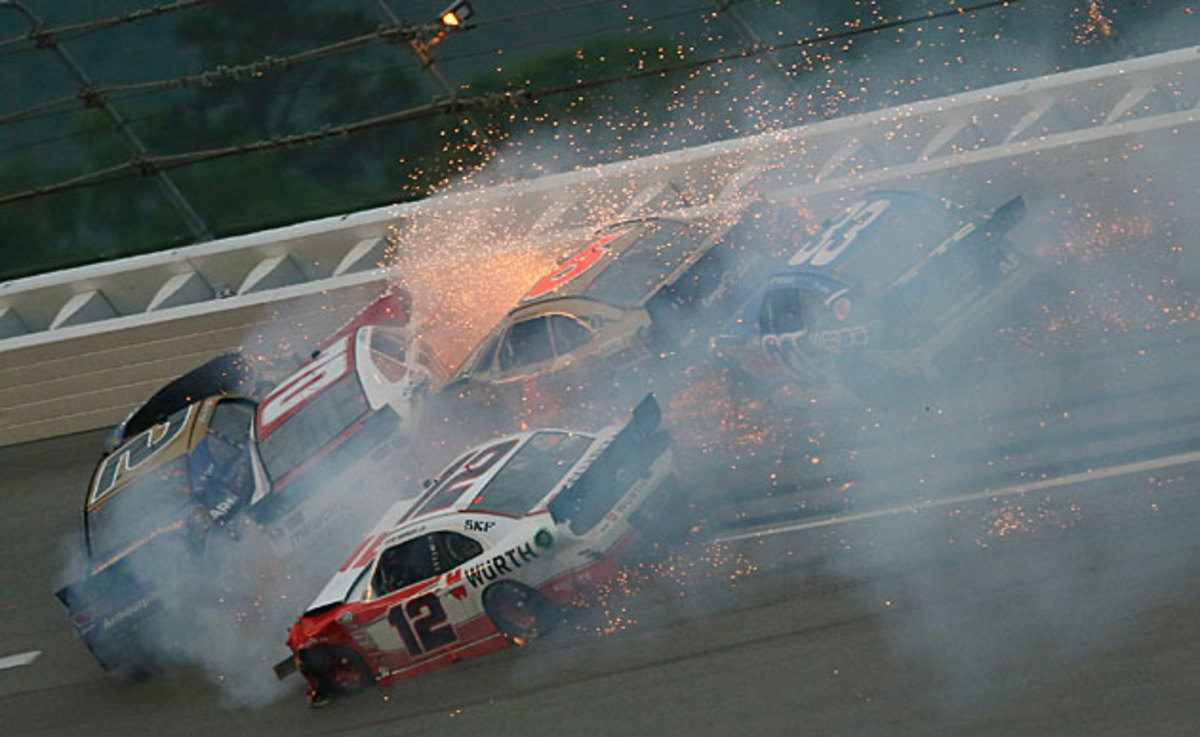
be worse.' I've grown a pretty thick skin over 21 years of running this place. It’s just what you hear.”
Logano: “It's not what I like, but I will say when I first started racing, when I wasn't very competitive week in and week out, I liked going because it equalized us. Well, now I have a shot on every track. I feel like I got good cars and I'm where I need to be as a driver. My team's where we need to be. I feel like I have a shot on every racetrack. When you go to Talladega and Daytona, it's not the advantage anymore that I used to have. It's kinda like, oh, man…”
Busch: “I have different categories for drivers on how they race, what their demeanor is, their aggressiveness, the level or awareness they have or don't have. And you have these categories for all these drivers and you just have a checklist, and if you see like four of 'em get grouped together, it's like, ooh. Something's gonna happen. Then you have different times in the race when the tires are wearing out and the cars are sliding around a little bit. But at the end of the day, why it happens at Daytona and Talladega, the Big One, is because we're not on edge. The cars, it's easy to hold 'em wide open at 100% throttle and stay in the draft with the other guy around you. At all the other tracks you can't hold it all the way around. And so it gets back to the driver having to feel his tires. And if you're good and you're car's handling good you're gonna start to pull away from those guys."
Pat Suhy, spotter for 15-year Cup veteran Kurt Busch: “The biggest thing is, the easiest way to explain it is when you're out there with 40 cars you create a big turbulence of air and pockets are moving. Driving down the highway you may get close to a tractor trailer. You'll be on the side of it, and you'll feel how it'll move the car around and buffet and pull you and bounce you. Or a big wind gust may come up and actually move you over as you're driving down the highway. This is what these guys fight all day long out there. Because you'll get somebody that'll side draft on you, which'll make you a little looser. You'll get one that gets underneath you that'll drag you down. Those are things, as a driver, that you understand when you get that run, how you keep that run going. Because if you don't keep the run going, you become the same speed as the car in front of you. So when you get a run, you've gotta make that run keep happening. So some guys will go up to the top and take the momentum where the car will wind up and keep going. But that's the easiest way to explain it. When you're driving, you're holding the wheel straight but you're really not going straight.”
Petty: “[Talladega] is not a physical race track. It's all mental. The drivers never get tired. But they're doing more thinking than they are driving, like What's he gonna do? What am I gonna do? Is this car gonna move out or is the position coming up gonna pass me or is he gonna get hung up with somebody else? So you're thinking all the time, probably doing more thinking in that race than any other race we run.
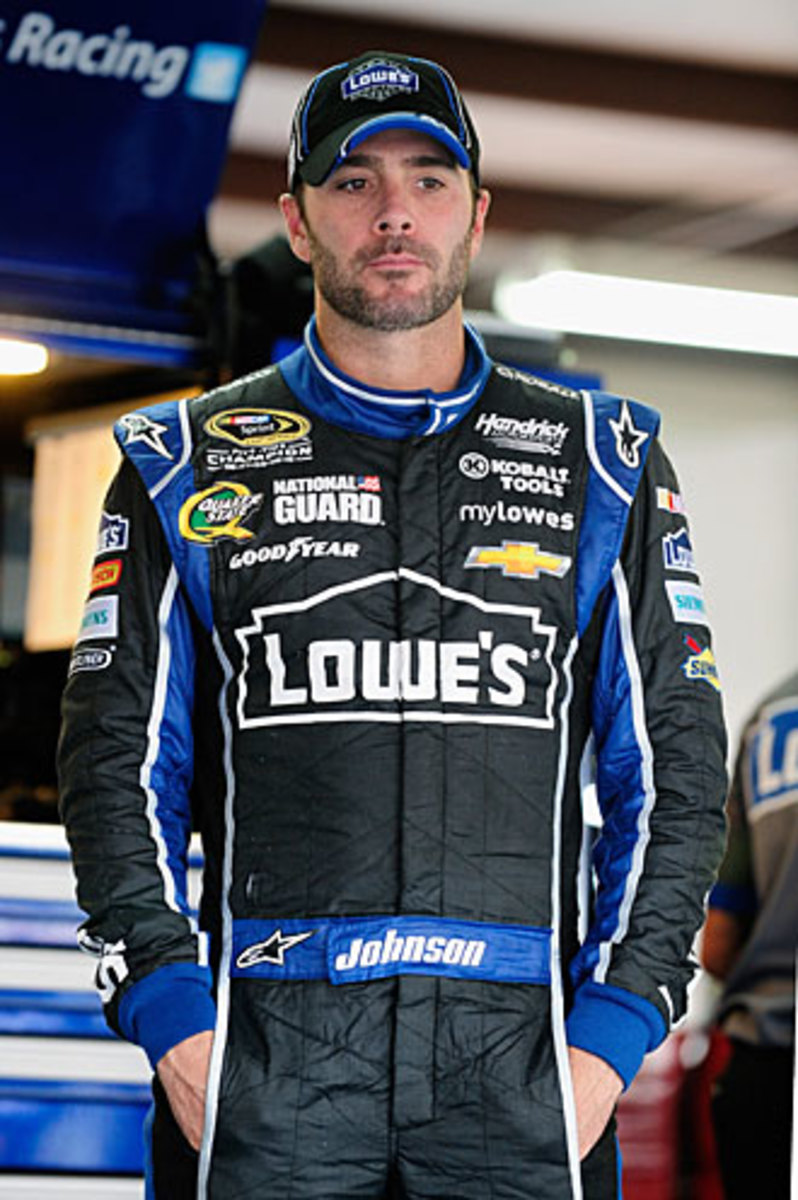
happen. And a lot of times if they can go ahead and have those big ones, then everybody's a little bit more relaxed.”
Jimmie Johnson, two-time ’Dega winner, six-time Sprint Cup champion: Those two guys [race winners Logano and Harvick] are gonna be the most calm, cool drivers on the racetrack. I promise you.
Keselowski: I don't feel like I’ll do a lot different. Maybe I should. You just try to control the things you can control, and at Talladega sometimes you have to accept the fact that it's not all under your control.
VIDEO COLLECTION:Watch Talladega's Big Ones through the years
